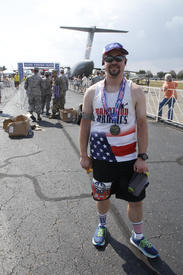Basals and exercise

jamie_lee80
Posts: 176 Member
I have been experimenting with this a lot over the past 6 months and can't get it right. What do you do when you are exercising? I go to the gym 4 nights a week and have 2 hours of classes 1 night a week, so I am pretty active in the evenings. Currently, I test before I go to the gym- anything under 130 I eat a protein bar with 20 g carbs and suspend my pump while i'm working out. Usually this works well for me, I come home and test and am in a normal range before I eat dinner. But sometimes it doesn't work out for me, even when I put the same effort into my workout. Last night I came home from the gym and was in the 230's.
2 days ago I fought lows all day long. I went to my exercise classes and came home in a high range again and then work up in the middle of the night at 33. I think that all of this up and down is really making my weight loss stall. I've been having a lot of lows lately and am cutting my own bolus/basal rates throughout the day to try to make them stop. I am wearing a sensor this week, which normally I don't do and am going to wait a few days before I send this data over to my dr to review.
Even if you don't have any advice, it feels nice to vent to people who can relate.
2 days ago I fought lows all day long. I went to my exercise classes and came home in a high range again and then work up in the middle of the night at 33. I think that all of this up and down is really making my weight loss stall. I've been having a lot of lows lately and am cutting my own bolus/basal rates throughout the day to try to make them stop. I am wearing a sensor this week, which normally I don't do and am going to wait a few days before I send this data over to my dr to review.
Even if you don't have any advice, it feels nice to vent to people who can relate.
0
Replies
-
I understand. Mon. I went to the gym in the 200's, did a temp. basal of 0 and exercised hard. I expected to finish at a normal BG, but ended up in the 300's afterwards.
Yesterday, I started in the upper 200's (279), did a temp. basal of 0 and exercised hard again. I ended in the 60's.
It just isn't always consistent. FWIW, I remember once reading a study that showed some type 1's will see increased BG's during exercise if they are at 80% or more of max HR. Of course, I was in that HR zone both Mon. and Wed., but only saw that result on Mon. But generally, I expect exercise to decrease my BG.0 -
Start a journal and take really good notes. Write down what your BG was before and after. Write down what you ate. Write down how you felt. Look for patterns. It might not be your basals at all but maybe something you ate is hitting you later because it was higher in fat or protein so you are high several hours after the workout. Then your body rebounds from the high and the exercise and the extra insulin so you end up way low many hours later. You should have a pattern that is "normal" for you. Also 2 hours might be too long to go without insulin. I would suggest you bolus a little bit in the middle of that. What happens is the insulin works for 5 hours so several hours after your workout you are without insulin which will cause highs. Exercise is known to cause high blood sugars from the stress on the body in many people. So if you started high and then exercised really hard its likely that you would go higher. I still exercise when I am high but I take insulin to cover the high and usually end up just fine.0
-
Great advice! You would think after 24 years this would get easier0
-
I'm also working on figuring out the right amount of temp basal to prevent hypos or having to have uncovered carbs before exercising. There's been a few times where stupid me would be at 300, take a full correction (not reducing my correction knowing my sensitivity will increase), walk around the neighborhood for 20 minutes, and drop 200mg/dL in that time frame. I have also been stupid enough to not test my BG before doing a quick one-mile walk around my university green and then test after that one mile walk and be in the 30s.
0 -
Sure, and sometimes stuff just happens. Last November, I was out camping with someone else. It was night and my BG was high (when I bundle up from cold weather, I think the tubing gets constricted in clothing but not enough for an error). I took another correction bolus in my sleeping bag without all the clothing restrictions (several layers), which took. Shortly after, the other person and I decided he wasn't going to make it through the night (it was about 0 degrees and he was having trouble staying warm). So we packed out and hiked out by light.
After a couple miles, I had an "oh crap" moment... I totally should have done a temp basal as soon as we started packing up. Anyway, I did a temp basal then and finished hiking the rest of the way back to the car (only about a mile or 2 more at that point). It just felt a little bit low, but not real bad. I tested when we reached the car and it was in the 30's. So I had basically dropped from 300's to 30's within 1-2 hours due to having insulin and exercise. But when I took the correction bolus, I didn't expect to be exercising that soon. Sometimes stuff just happens...0 -
Actually I think it does get easier the longer you have it. Its still awful but after 30+ years of dealing with it I find that I am way better equipped to make adjustments on my own or handle things that are not part of my usual plan. I'm sure you are too! Those who just got diagnosed are afraid to change their basals and often go weeks dealing with a problem waiting for an endo appointment. We adjust as needed and aren't afraid to try stuff out. Like Midwest said, sometimes stuff just happens and we take it in stride.0
-
I'm a pretty old Type 1 (got it in 1969!) but here's some things I think I've learned and I keep learning from you all every day.
It does involve how much aerobic and how much anaerobic effort we put into the workout. I get a lot of good advice from Sheri Colberg's book, "The Diabetic Athlete's Handbook." She is type 1 and an avid athlete. I try to think of insulin like a "wave of coverage" since what I do with the basal right now, actually affects me in a couple hours--not right now. So...if I know I have a moderate workout every day at 5pm, I would reduce my temp basal about 25% or more, at about 3:45 pm--so entering the gym my basal is already reduced and ready, BUT not gone by suspending. Suspending, for me, is too much and gives me a bad bonk later and high BG.
I think several people have also agreed starting about 150-180 mg/dL, works best for most workouts and add 15 grams (about every 30 minutes) if it starts to drop--I can see that on cgm, and don't add glucose if BG is okay.
If I'm going to be hiking--so aerobic but not intense like backpacking, I would reduce by ~50%.
Supposedly, for planned activity, it would be something like "reduce for the hour before, for the length of time working out, and for most people, about an hour after. But the muscles keep working and metabolizing for 12-24 hours after, so "stuff happens."
This can change when weights (or for me, when I went backpacking) are involved since this muscular anaerobic work can both lower and then raise BG for many folks. I've been pretty sedentary for years and then the last year I've been experimenting with all of this. Frankly, using a sensor, I'm seeing just like you've all said. Different things on different days, but there are some patterns for me that are starting to emerge. Since our body's don't shut off the insulin, we've got to make those adjustments ahead. If it's unplanned activity, we WILL need to keep adding glucose--which is a drag, but the reality.0 -
I use a CGM but not a pump. Exercising has always been challenging for me. Plan to read the book you mentioned and see if it helps. Thanks!0
-
I think it also depends on what time of the day you exercise. When I did my cardio-strength training workout in the afternoon, I would end up with a bad low. However, since I switched to 5:30am workout time, by BG level is absolutely the same before and after I workout. I do 45 mins of cardio and 15 mins of strength training. Maybe some people's blood sugars are more stable in the AM? Sometimes I wake up on the higher side, like this AM it was 240 (dang it) at 5AM, and I gave myself a correction bolus before I went to the gym. I did not go low. So, all I'm saying is try working out at different times of the day and see how this goes.0
This discussion has been closed.





